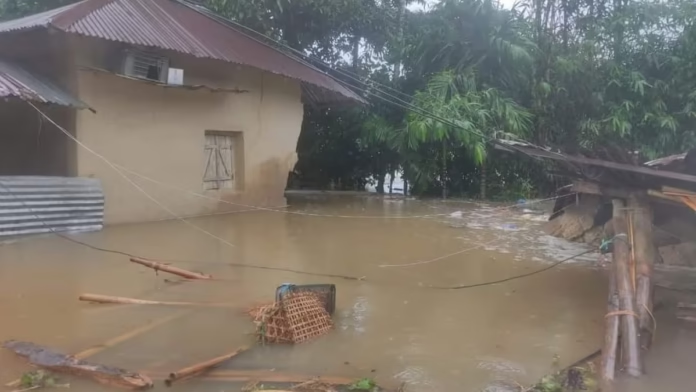A powerful storm swept across Tripura in the early hours of April 21, leaving a trail of destruction in several parts of the state. The storm battered homes, uprooted trees, and triggered widespread panic among residents. Mohanpur and Karbook bore the brunt of the storm’s fury, where the damage reached alarming levels. Authorities confirmed that 445 houses were either fully destroyed, partially damaged, or severely affected by the onslaught of heavy rain and strong winds.
In Mohanpur, the storm tore through residential areas with violent force. Tin roofs flew off, boundary walls collapsed, and people scrambled for shelter in the middle of the night. Local residents reported hearing loud crashes as trees fell and electric poles snapped, plunging several neighborhoods into darkness. Two individuals suffered injuries in the chaos when a roof collapsed on them during the storm. Emergency teams responded swiftly and transported them to nearby hospitals for treatment. Medical staff confirmed that the injured were out of danger but would require rest and monitoring due to trauma and minor fractures.
Karbook experienced similar devastation. The storm destroyed large sections of homes and disrupted communication lines. Local officials visited affected villages and recorded extensive damage to personal property. Residents recounted their terror as the storm intensified without warning, giving them little time to prepare. In some areas, families abandoned their homes and sought safety in nearby community halls and schools, where authorities later distributed basic supplies.
The state disaster management team swung into action as soon as reports of damage poured in. Officials coordinated with local police, health workers, and municipal staff to assess the extent of destruction. They deployed teams to conduct damage surveys and ensure that the affected households received temporary shelter and aid. Relief camps began operating in the worst-hit areas by late morning, providing food, water, and essential supplies to dozens of displaced families.
State officials confirmed that the storm did not discriminate in its path, as it damaged houses made of both concrete and mud. In rural areas, the storm shattered windows, flattened walls, and carried away tin sheets and wooden planks. Farmers watched helplessly as the wind uprooted banana plants, bent bamboo groves, and flattened small kitchen gardens. Livelihoods suffered a setback, as many households rely on subsistence farming for daily survival.
Electricity supply also took a major hit in several regions, including Mohanpur and Karbook. The strong winds knocked down power lines and damaged transformers. Technicians struggled to restore power amidst heavy rains and debris-clogged roads. Authorities warned residents to stay away from fallen electric wires until repairs could be completed. With communication networks down in some areas, people turned to local community centers for updates and support.
The chief minister expressed concern over the situation and instructed district authorities to provide all necessary assistance to the victims. He assured the public that the government would not delay compensation for those who suffered losses. He also directed teams to remain on high alert as weather forecasts predicted more rainfall in the coming days. Emergency helplines were activated to assist residents seeking help with medical care or shelter.
Schools remained closed in affected districts as a precautionary measure. Teachers and staff helped local administration in coordinating relief work and identifying families in urgent need. Volunteers joined efforts to clear fallen trees from roads, allowing ambulances and supply trucks to reach remote areas more quickly. Religious and social organizations opened their doors to shelter the displaced and distribute cooked meals.
As the storm subsided, residents began returning to their damaged homes. Some tried to salvage what they could from the wreckage, while others remained in relief centers awaiting further instructions. The air hung heavy with anxiety and uncertainty, but community members supported each other with resilience and hope.
With more rain expected, authorities are continuing to monitor the situation closely. Officials urged residents to remain cautious, keep emergency kits ready, and stay updated through official channels. While the storm has passed, the road to recovery has only just begun for the people of Tripura.




